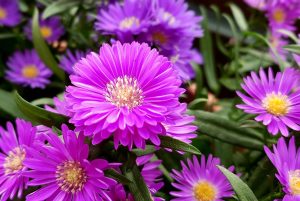 “The aster has not wasted spring and summer because it has not blossomed. It has been all the time preparing for what is to follow, and in autumn it is the glory of the field.” —Henry Ward Beecher
“The aster has not wasted spring and summer because it has not blossomed. It has been all the time preparing for what is to follow, and in autumn it is the glory of the field.” —Henry Ward Beecher
Chrysanthemums (mums) are generally thought of as the go-to fall blooming flower. However, they can be temperamental and do not always make it through our tough Wisconsin winters. A much hardier, more reliable, yet equally beautiful, alternative is the aster.
The word aster means “star” in Latin and the origin of the flower is steeped in legend. According to Greek lore, the god Astraea wept, her tears falling as stardust and creating the beautiful star-shaped aster. The flower was thought to be sacred, so the Greeks used wreaths of these flowers to adorn altars. In medieval Europe, plants were burned to frighten away serpents. Originally the English translated asters as “starwort” but changed the name to “Michaelmas Daisy” as it blooms around St. Michaelmas Day in September. This naming convention remains in use today.
Native Americans have yet another legend. Two young maids fled from armed conflict into the woods to seek refuge. They sought the help of an Herb Woman who sprinkled them with her herbal mixtures as they slept. The next morning, the girls were gone and in their place were two flowers, a purple aster and a yellow goldenrod.
Regardless of their origin, asters are a splendid flower to include in your landscape. They come in a wide range of sizes and colors but all have the same basic characteristics. The flower has a distinct star shape, somewhat resembling a daisy, but is actually made up of hundreds of tiny florets.
The center of the flower is flat yellow/orange florets, surrounded by rays of one-colored petals. The petals can be red, pink, blue, lavender, purple, or white. Most flowers are 1–2 inches in size, but some may be smaller. The leaves are long, narrow, and mildly hairy.
The plant itself can range from six inches to eight feet tall, but the ones most commonly used in home gardens will only reach three feet. Because of their height, they may want to topple over during the growing season. Shear back or pinch back by one third in midsummer to encourage branching and make a bushy rather than leggy plant.
One added benefit of asters is that they are pollinator magnets. It is not uncommon to see several species of bees and butterflies clustered around the blooms dining on the nectar.
Asters are divided into two categories: New England asters (Aster novae-angliae) and New York asters (Aster novi-belgii), also called Michaelmas daisy. New York asters are typically shorter—usually about one foot tall. New England asters will be at least three feet tall.
Plant asters in a location with well-drained, rich soil and full sun exposure. Do not crowd them since powdery mildew is possible. Allow for good air circulation by separating the shorter ones by at least a foot and the taller ones at three feet. Dead head the spent flowers to prolong the bloom time. For a great fall show, combine asters with Joe-Pye weed, Goldenrod, and Coneflower, along with an ornamental grass.
Carol Shirk
Certified Master Gardener




